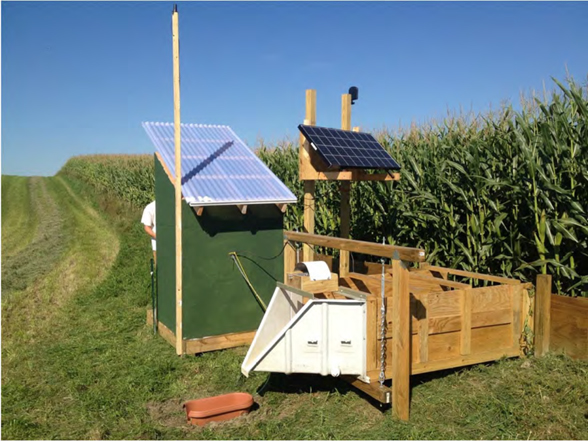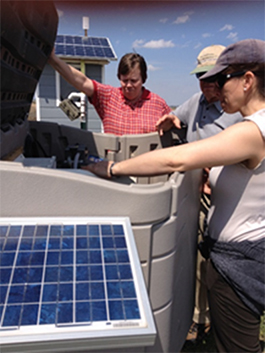In celebration of National Water Quality Month, USDA is highlighting the voluntary programs and services that are available to farmers to help protect and improve water quality. In this Ask the Expert, Karma Anderson answers questions about how USDA’s Natural Resources Conservation Service (NRCS) works with farmers in target watersheds across the country to quantify the water quality impacts of voluntary conservation through edge-of-field monitoring.

How is NRCS working with farmers to help them better assess the impacts of conservation practices, specifically on water quality?
NRCS’ National Water Quality and Quantity Team helps farmers and conservationists learn more about the science behind the agency’s voluntary conservation programs. Our team of 11 conservationists provides water quality and quantity technical leadership and technology development.
We are also leading implementation of NRCS’ edge-of-field water quality monitoring activities which offers technical and financial assistance to farmers in key watersheds nationwide. NRCS first introduced this monitoring as an opportunity through the Environmental Quality Incentives Program (EQIP) in 2013. Since then, we have allocated $6.7 million for 43 projects in 12 states, with 12 projects completed and 9 more projects wrapping up this year.
What is edge-of-field monitoring and why is it important?
The monitoring program evaluates runoff at the edge of a farm field to assess water quality improvements from conservation systems such as nutrient management, cover crops, and irrigation water management. Through EQIP, NRCS provides one-on-one technical support and financial assistance to farmers to help them install monitoring stations that measure runoff from fields and the amount of sediment and nutrients – nitrogen and phosphorus – contained within that runoff. This technology helps producers better understand the effects that their in-field conservation efforts have on the amount of runoff, sediment, and nutrients flowing off their fields to adjacent waterways and downstream. This is powerful knowledge for producers who are perpetually honing their management to sustain production while minimizing offsite impacts to water quality.
What does an edge-of-field project look like?

Edge-of-field projects monitor runoff and water quality from two or more fields with similar characteristics, like crops, soils, slope, and area. One field is the control, where management and operations remain the same throughout the project. The other fields are treatment fields, where select conservation practices are implemented over the course of the project. Projects have durations from five to nine years depending on crop rotation and the producer’s objectives. At the end of the project, we can accurately quantify the effects of the conservation practices on multiple water quality metrics.
Each project’s monitoring approach and treatment regimen is outlined in a plan produced with the help of NRCS subject matter experts and partners, in consultation with the farmer. This plan is the foundation of each project and ensures that the monitoring approach will be sufficient to demonstrate the effects of conservation practices on water quality.
Currently, the program requires a commitment of up to nine years, depending on the crop rotation. While NRCS offers 75 percent of the financial cost to setup the monitoring system, participants do incur costs for the equipment, so it can be a big investment. The good news is that we are working to make the program more accessible to more producers, and are hoping to rollout a new, less cost intensive program next year for those wishing to voluntarily participate.
What do farmers learn from edge-of-field monitoring activities and how can it help with their conservation planning goals?
Edge-of-field water quality monitoring helps us evaluate the benefits of conservation at the field level which can help farmers sustain, or even increase yields, while also conserving natural resources. The information helps maximize conservation benefits while keeping pocketbooks out of the red. In many cases, edge-of-field projects provide insights beyond “how a specific conservation practice, or suite of practices, affects water quality.” This includes how the timing of common management activities, like tillage and nutrient application, can impact runoff and water quality.
How else are data from edge-of-field monitoring projects used?
The insights gained from edge-of-field monitoring projects are also valuable to NRCS, researchers, and conservationists that are looking for more effective ways to conserve natural resources. Data can be used to establish expectations of practice effectiveness in a locality or region and in some cases, we learn about the trade-offs of some practices. For instance, erosion may be reduced, but we observe more nitrate loss. This information ultimately leads to better conservation planning and practice design.

How can farmers learn more about edge-of-field monitoring?
Learn more here or contact the NRCS office at your local USDA Service Center.
Read more about how you can protect water quality.
Karma Anderson is the NRCS National Water Quality and Quantity Leader located in Portland, Oregon. She can be reached at karma.anderson@usda.gov.


